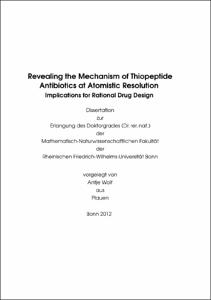Revealing the Mechanism of Thiopeptide Antibiotics at Atomistic ResolutionImplications for Rational Drug Design

Revealing the Mechanism of Thiopeptide Antibiotics at Atomistic Resolution
Implications for Rational Drug Design

| dc.contributor.advisor | Hofmann-Apitius, Martin | |
| dc.contributor.author | Wolf, Antje | |
| dc.date.accessioned | 2020-04-17T23:09:56Z | |
| dc.date.available | 2020-04-17T23:09:56Z | |
| dc.date.issued | 18.07.2012 | |
| dc.identifier.uri | https://hdl.handle.net/20.500.11811/5333 | |
| dc.description.abstract | For decades drug design has primarily focused on small molecules that bind to well-formed tight binding pockets, such as the catalytic centers of enzymes. Recently, there is increasing interest to design compounds that disrupt or stabilize biomacromolecular interfaces (e.g. protein–protein, protein–DNA, protein–RNA, protein–lipid interfaces). These non-traditional drug targets hold great therapeutic potential as they govern cellular pathways. In contrast to traditional drug targets, where computational methods are now routinely and productively used to complement experiments, the use of computer-based approaches for the study and design of interfacial modulators is still in its infancy. The current thesis is a first detailed study into understanding the effects of modulators of a protein–RNA interface and developing computer-based approaches for their design. This work focuses on the 23S-L11 subunit of the ribosomal GTPase-associated region (GAR), a prototypic protein–RNA interface of high relevance in the development of novel antibacterials. The GAR is the target of naturally occuring thiopeptide antibiotics. These unique molecules are effective inhibitors of bacterial protein synthesis, but are currently unused in human antibacterial therapy due to their low aqueous solubility. Their mechanism of action is explored in the current thesis, enabling the design and proposition of new chemical scaffolds targeting their binding site. The specific challenges associated with the 23-SL11-thiopeptide system, such as the inherent flexibility of the protein–RNA composite environment and the size and structural complexity of the thiopeptide ligands, are addressed by a combination of computational chemistry approaches at different levels of granularity and a steady feedback with experimental data to validate and improve the computational techniques. These approaches range from quantummechanics for deriving optimized intramolecular parameters and partial atomic charges for the thiopeptide compounds, to molecular dynamics simulations accounting for the binding site’s flexibility, to molecular docking studies for predicting the binding modes of different thiopeptides and derivatives. All-atom molecular dynamics simulations were conducted, providing a detailed understanding of the effect of thiopeptide binding at a previously unmet resolution. The findings of this work, coupled with previous experimental knowledge, strongly support the hypothesis that restricting the binding site’s conformational flexibility is an important component of the thiopeptide antibiotics’ mode of action. With the help of an MD-docking-MD workflow and an energy decomposition analysis crucial residues of the binding site and pharmacologically relevant moieties within the ligand structures could be identified. A 4D-pharmacophore model is presented that was derived from a refined 23S-L11-thiopeptide complex and additionally accounts for the dynamic stability of molecular interactions formed between the antibiotic and the ribosomal binding site as the fourth dimension. The results of this thesis revealed, for the first time, a plausable description of the thiopeptide antibiotics’ mode of action, down to the details of their pharmacologically relevant parts and provide a computational framework for the design of new ligands. | |
| dc.language.iso | eng | |
| dc.rights | In Copyright | |
| dc.rights.uri | http://rightsstatements.org/vocab/InC/1.0/ | |
| dc.subject | Thiopeptidantibiotika | |
| dc.subject | Ribosom | |
| dc.subject | computergestützte Medikamentenentwicklung | |
| dc.subject | Thiopeptide antibiotics | |
| dc.subject | Ribosome | |
| dc.subject | Computer-aided drug design | |
| dc.subject.ddc | 540 Chemie | |
| dc.subject.ddc | 570 Biowissenschaften, Biologie | |
| dc.subject.ddc | 610 Medizin, Gesundheit | |
| dc.title | Revealing the Mechanism of Thiopeptide Antibiotics at Atomistic Resolution | |
| dc.title.alternative | Implications for Rational Drug Design | |
| dc.type | Dissertation oder Habilitation | |
| dc.publisher.name | Universitäts- und Landesbibliothek Bonn | |
| dc.publisher.location | Bonn | |
| dc.rights.accessRights | openAccess | |
| dc.identifier.urn | https://nbn-resolving.org/urn:nbn:de:hbz:5n-29041 | |
| ulbbn.pubtype | Erstveröffentlichung | |
| ulbbnediss.affiliation.name | Rheinische Friedrich-Wilhelms-Universität Bonn | |
| ulbbnediss.affiliation.location | Bonn | |
| ulbbnediss.thesis.level | Dissertation | |
| ulbbnediss.dissID | 2904 | |
| ulbbnediss.date.accepted | 18.06.2012 | |
| ulbbnediss.fakultaet | Mathematisch-Naturwissenschaftliche Fakultät | |
| dc.contributor.coReferee | Wiese, Michael |
Dateien zu dieser Ressource
Das Dokument erscheint in:
-
E-Dissertationen (4118)




